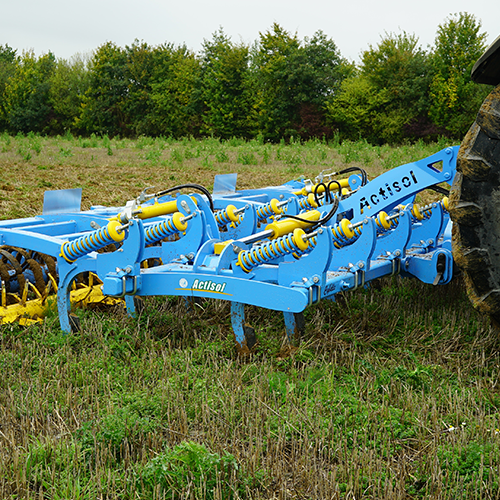Showing all 2 results
Mechanical weeding by Actisol
Are you looking for an environmentally-friendly alternative for weeding your soil? Scalping is certainly the technique for you. Specialised agricultural machinery is at your service: mechanical weeder.
What is a mechanical weeder?
A mechanical weeder is a toothed tool that works the soil at a depth of 3 to 5 cm. It is the alternative to chemical weeding through the use of a tool fitted with scalping blades which undercut the weed.
The advantages of using a scalper
Land clearing
The purpose of a mechanical weeder is to clear the land for the crops to follow by destroying the weeds or regrowth of past crops in a mechanical and direct manner. The mechanical weeder can also be used to destroy fields without using a plough
A practice that respects the soil
This machinery is perfectly suitable for sustainable farming and soil conservation techniques. In fact, very shallow work (shallow working depth) does not damage the horizons and does not harm the life they contain. Mechanical weeding of plots also limits the use of chemical weed killers as much as possible, which has a positive impact on groundwater quality.
An energy-efficient technique
Shallow work also reduces fuel consumption which is closely monitored by farmers and important for reducing greenhouse gases.By scalping a finer quantity of soil, resistance is lower and the force required from the tractor is also less.
Mechanical weeding can be used on all plots provided it is carried out on drained soil to avoid any smoothing.
Mechanical weeding: Actisol’s identity
Actisol has developed a special blade that can be fitted on its machinery. The latter has been designed not to cut the weeds at the collar as can happen with certain conventional mechanical weeder mouldboards, but rather it extirpates them with the aim of complete destruction. This special swallow blade is available in widths of 40 or 46 cm.
Total extirpation is made possible by the blade’s very horizontal work and its sufficient thickness. As such, the weeds, completely removed from the soil, no longer have access to the resources necessary for their survival. This blade is formidable on plants with rhizomes which, if they are cut, can very quickly become invasive (thistles, quack grass, rumex, etc.). The consequences of poor management of these plants can go as far as causing the destruction of an existing crop mechanically or chemically because it is considered too dirty.
You will agree that the term extirpation is much more appropriate to Actisol’s expertise.
Scalpers developed by Actisol
The Actisol range has two pieces of machinery fitted with its unique, fine and fluid tooth with possible assembly with swallow or standard blades for mechanical agricultural weeding.
Demeter
The Demeter features a fixed frame and has two or three rows of teeth. Its working width is 2.5 m to 4.2 m. This range of machinery is designed to equip all tractor powers.
Cybelle
The Cybelle has two rows of teeth. This machinery can be folded to achieve a suitable height and width for road transport; it works on widths ranging from 4 to 5 m.
Choosing the right mechanical weeder
The specificities are the same for these two pieces of machinery. Only their working volume is different. Equipped with swallow blades and mouldboard bases, they will efficiently clear your plots. The bases, adjusted correctly, turn over the rhizomes, causing them to dry out quickly without mixing the soil.
To create an ideal seedbed in a single pass, they are fitted with a double roller system with independent adjustments behind the teeth (mixteur + press).
The Demeter and the Cybelle are equipped to accommodate a 3-row harrow behind the press roller for more all-round work. This harrow, due to its raking effect, pulls the freshly extirpated weed to the soil surface.
This action speeds up the soil loosening process (removal of soil around the root system). If the weather conditions are ideal (no rain), mechanical weeding carried out at the right time (depending on the weed type) can result in total destruction of the weed within 10 days.
Our mechanical weeders are farm machinery that have been designed to meet your needs for versatility. They can also be equipped with wear parts for cracking or stubble working.
In short, mechanical weeder for agriculture is a mechanical weeding solution that respects your soil and nature, and is in line with Actisol’s values.
If you’d like to find out more about the subject and get advice that’s as close as possible to your needs, get in touch with our team, who will be delighted to advise you on the right equipment for you./span>




